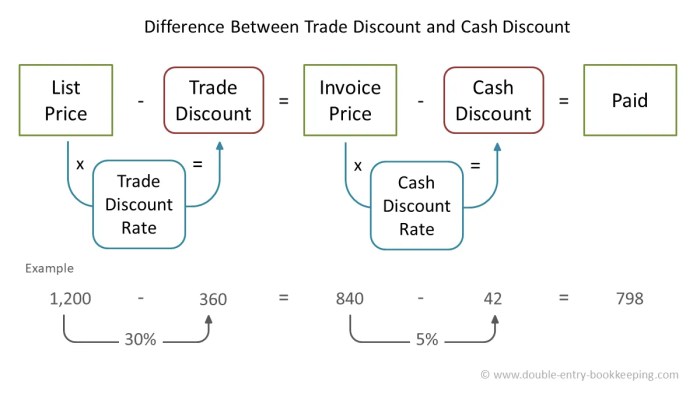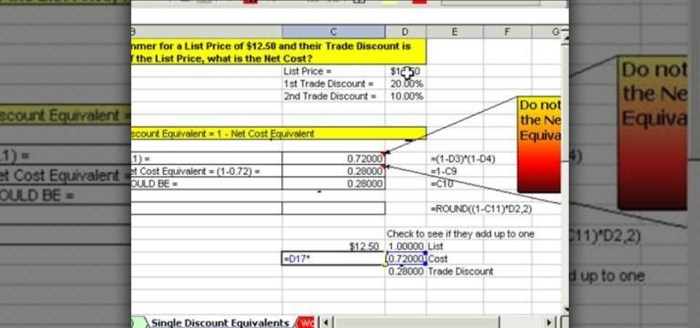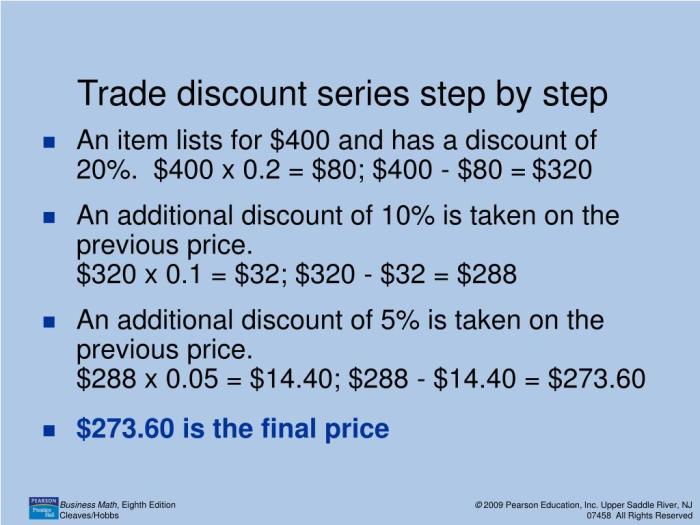Embarking on the series of trade discounts crossword, we delve into the intricacies of this widely used pricing strategy, exploring its calculations, advantages, and industry applications. This comprehensive guide will unravel the complexities of trade discounts, empowering you with a thorough understanding of their impact on financial statements and ethical considerations.
Throughout this discussion, we will uncover the nuances of series of trade discounts, contrasting them with other discounting methods to provide a clear understanding of their suitability in various scenarios. Additionally, we will examine the legal and ethical implications associated with trade discounts, ensuring transparent and ethical business practices.
Series of Trade Discounts

A series of trade discounts is a sequence of discounts applied to a product’s list price. Each discount is calculated as a percentage of the previous discounted price, resulting in a cumulative discount on the original price.
Calculation of Series of Trade Discounts
To calculate a series of trade discounts, follow these steps:
- Convert each trade discount percentage to its decimal equivalent (e.g., 20% becomes 0.20).
- Multiply the list price by the first discount decimal to get the first discounted price.
- Multiply the first discounted price by the second discount decimal to get the second discounted price.
- Continue this process for all trade discounts in the series.
- The final discounted price is the result of the last multiplication.
Examples of Series of Trade Discounts
Consider a product with a list price of $100 and a series of trade discounts of 10%, 15%, and 5%:
First discount: $100 x 0.90 = $90Second discount: $90 x 0.85 = $76.50Third discount: $76.50 x 0.95 = $72.68
The final discounted price is $72.68.
Applications of Series of Trade Discounts: Series Of Trade Discounts Crossword

Series of trade discounts offer advantages and disadvantages, and their use varies across industries. Understanding these factors is crucial for effective pricing strategies.
Advantages of Series of Trade Discounts
- Simplicity:Multiple discounts are combined into a single rate, simplifying calculations.
- Negotiation Flexibility:Discounts can be tailored to specific customer needs, allowing for flexibility in pricing.
- Enhanced Customer Relationships:Offering discounts can foster positive customer relationships and encourage repeat business.
Disadvantages of Series of Trade Discounts
- Complexity in Calculations:Determining the final price can be complex, especially with multiple discounts.
- Lack of Transparency:Discounts can be hidden within the series, making it challenging for customers to compare prices.
- Potential for Errors:Manual calculations can lead to errors in determining the final price.
Industries Using Series of Trade Discounts
Series of trade discounts are commonly used in industries with complex supply chains, such as:
- Manufacturing
- Distribution
- Retail
Impact on Pricing Strategies
Series of trade discounts can significantly impact pricing strategies. By offering discounts, businesses can:
- Increase Sales:Discounts can make products more affordable, stimulating demand.
- Differentiate Products:Unique discount structures can differentiate products from competitors.
- Manage Inventory:Discounts can help clear excess inventory by making products more attractive to customers.
Comparison with Other Discounting Methods

Series of trade discounts is one of the several discounting methods used in business transactions. Other common methods include single trade discounts and chain discounts. Each method has its own advantages and disadvantages, and the most appropriate method for a particular situation will depend on the specific circumstances.
Single Trade Discounts
A single trade discount is a single percentage discount that is applied to the list price of an item. This method is simple to calculate and is often used when only a single discount is being offered.
Chain Discounts
Chain discounts are a series of discounts that are applied sequentially to the list price of an item. Each discount is applied to the net price after the previous discount has been applied. This method is more complex to calculate than a single trade discount, but it can result in a greater overall discount.
Comparison of Methods
The following table compares the key differences between series of trade discounts, single trade discounts, and chain discounts:
| Method | Number of Discounts | Calculation | Advantages | Disadvantages |
|---|---|---|---|---|
| Series of Trade Discounts | Multiple | Each discount is applied to the net price after the previous discount has been applied. | Can result in a greater overall discount. | More complex to calculate than a single trade discount. |
| Single Trade Discounts | One | A single percentage discount is applied to the list price of an item. | Simple to calculate. | May not result in as great a discount as a series of trade discounts. |
| Chain Discounts | Multiple | A series of discounts that are applied sequentially to the list price of an item. | Can result in a greater overall discount than a single trade discount. | More complex to calculate than a single trade discount. |
Appropriate Situations, Series of trade discounts crossword
Series of trade discounts are most appropriate when a large number of discounts are being offered and when the discounts are relatively small. Single trade discounts are most appropriate when only a single discount is being offered or when the discount is relatively large.
Chain discounts are most appropriate when a series of discounts are being offered and when the discounts are relatively large.
Impact on Financial Statements

Series of trade discounts significantly impact the financial statements of both buyers and sellers. For buyers, the discounts reduce the cost of goods purchased, affecting their income statement and balance sheet. For sellers, the discounts reduce revenue and accounts receivable, impacting their income statement and balance sheet.
Accounting Entries for Series of Trade Discounts
The accounting entries for series of trade discounts involve recording the purchase or sale at the net amount after applying all discounts and recognizing the discount amounts separately. The following entries illustrate the accounting for a purchase transaction:
- Debit: Inventory (net amount)
- Debit: Discount Received (discount amount)
- Credit: Accounts Payable (gross amount)
For the seller, the entries would be:
- Debit: Accounts Receivable (gross amount)
- Credit: Sales Revenue (net amount)
- Credit: Sales Discount (discount amount)
Impact on Financial Statement Line Items
| Financial Statement Line Item | Impact on Buyers | Impact on Sellers |
|---|---|---|
| Cost of Goods Sold | Decrease | N/A |
| Inventory | Decrease | N/A |
| Sales Revenue | N/A | Decrease |
| Accounts Receivable | N/A | Decrease |
Legal and Ethical Considerations

The use of series of trade discounts involves legal and ethical considerations that businesses must be aware of to avoid disputes and maintain transparency. Understanding these considerations is crucial for ethical business practices.
One important legal consideration is the potential for deceptive pricing practices. Businesses must clearly disclose all discounts and terms to customers to prevent confusion or misunderstandings. Misrepresenting discounts or failing to disclose all applicable terms can violate consumer protection laws and damage the company’s reputation.
Best Practices for Ethical Use of Series of Trade Discounts
- Clear and Transparent Communication:Businesses should provide customers with clear and detailed information about all discounts, including the base price, discount rates, and any additional terms or conditions.
- Written Agreements:It is advisable to document all trade discount agreements in writing to avoid disputes and ensure a clear understanding between parties.
- Avoid Hidden Discounts:Businesses should avoid using hidden discounts or discounts that are not clearly communicated to customers. This can lead to misunderstandings and damage trust.
- Compliance with Industry Standards:Businesses should adhere to industry standards and best practices related to the use of trade discounts. This helps ensure consistency and fairness in the marketplace.
- Ethical Considerations:Businesses should consider the ethical implications of using trade discounts, ensuring that they are not used to deceive customers or gain an unfair advantage.
Expert Answers
What is the primary advantage of using series of trade discounts?
Series of trade discounts offer flexibility in pricing, allowing businesses to tailor discounts to specific customer segments or order quantities.
How do series of trade discounts impact financial statements?
Trade discounts reduce the recorded sales revenue and cost of goods sold for the seller, while increasing the recorded purchases and cost of goods sold for the buyer.
What are some ethical considerations related to trade discounts?
Businesses should ensure transparency in disclosing trade discounts to avoid potential disputes or misunderstandings, and they should avoid using trade discounts as a means of deceptive pricing.